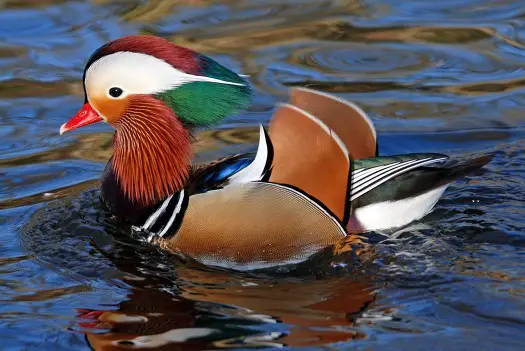The mandarin duck (Aix galericulata) is a perching duck that typically occurs all throughout the Asia including eastern China and Russia and many parts of Europe. It is thought to make habitats near water and like many birds mandarin nests in tree holes. The duck rarely flies away from lakes or rivers.
Mandarin Duck Facts
Anatomy
- Adult mandarins measure 41–49 cm (16–19 in) in body length with the wingspan averaging 65–75 cm (26–30 in).
- The average weight of mandarins is about 1 – 1.5 pounds.
- Mandarins have long tail and short wings. The duck’s tail helps the bird to maneuver quite efficiently into the trees. The bird rapidly beats its wings.
- Adult males are mainly recognized by their red bill and white crescent which is patterned just above the eye.
- Mandarins have purple breast and orange ‘sails’ on the back.
- Males show much prominent crest as compared to the female’s.
- They have got sharp claws that are set at the end of their webbed feet.
- The male mandarin is called ‘drake’. When the breeding season is over, the drake molts its feathers and shows eclipse plumage.

Range & Habitat
- Mandarins are native to Asia. Many mandarin ducks are found in the eastern China, Japan, and eastern Russia. Many ducks occur in Europe and southeast England.
- Mandarins are likely to make homes in temperate habitats including broad-leaved forests and others along the forest streams. They would like to live near watery places and their habitats must be abundant in bankside vegetation such as shrubs, reeds, and trees.
- They will avoid open habitats and large expanses of water. Small flocks of mandarins occupy rice fields to forage.
- The northern population seems to migrate south in winter. They are thought to spend cold days in the China’s Yangtze River.
- Britain is home to 300 – 400 breeding pairs. All of them are in the wild. The isolated population is also found in the Gloucestershire Norfolk, and Tayside.
Feeding Ecology & Diet
- Mandarins typically search food on land as well as underwater. They will feed on submerged food while swimming and also eat debris on the bank.
- Mandarin ducks consume vegetation which makes up much of the duck’s diet. The duck supplements its diet with small insects. During autumn mandarins seem to rely on land snails.
- The Russian population eats many seeds including aquatic plants, beetles, acorns, and small fish. In Britain, the mandarin consumes beechmast, chestnuts, waterside insects, and acorns.

Reproductive Biology
- Mandarins are highly social as they are found in flocks containing as many individuals as 60.
- They will feed constantly all day long but remain most active in mornings and evenings.
- The breeding occurs in the spring season.
- The duck can also walk on land in the same way as it swims.
- Ducklings become fully independent in 42 days. Females choose their partners in spring season.
- A female lays 9 – 12 eggs.
- Ducklings fledge out in about 42 days.
- The breeding interval is one year.
- Mandarins achieve maturity at one year of age.
- The incubation lasts 28 days.
- The average life expectancy is 3 – 6 years.
- Predators of mandarin duck include raccoon dogs, Eurasian eagle owls, mink, polecats, grass snakes, and otters.
Conservation Status
Least Concern






Leave a Reply